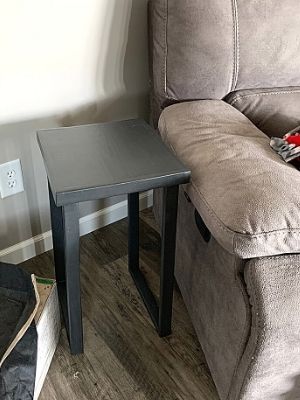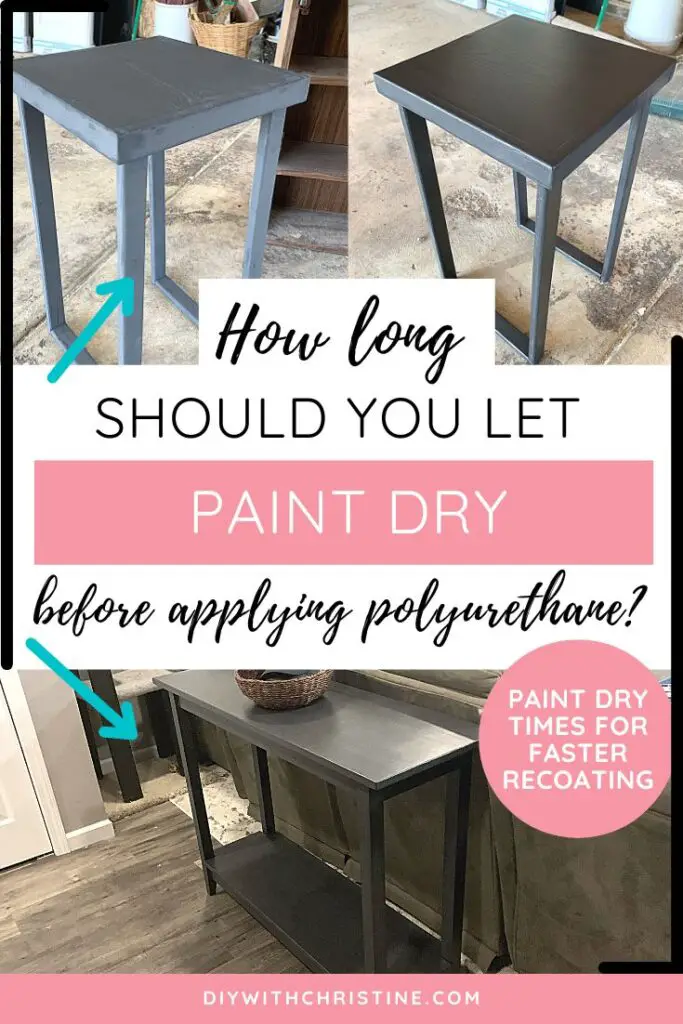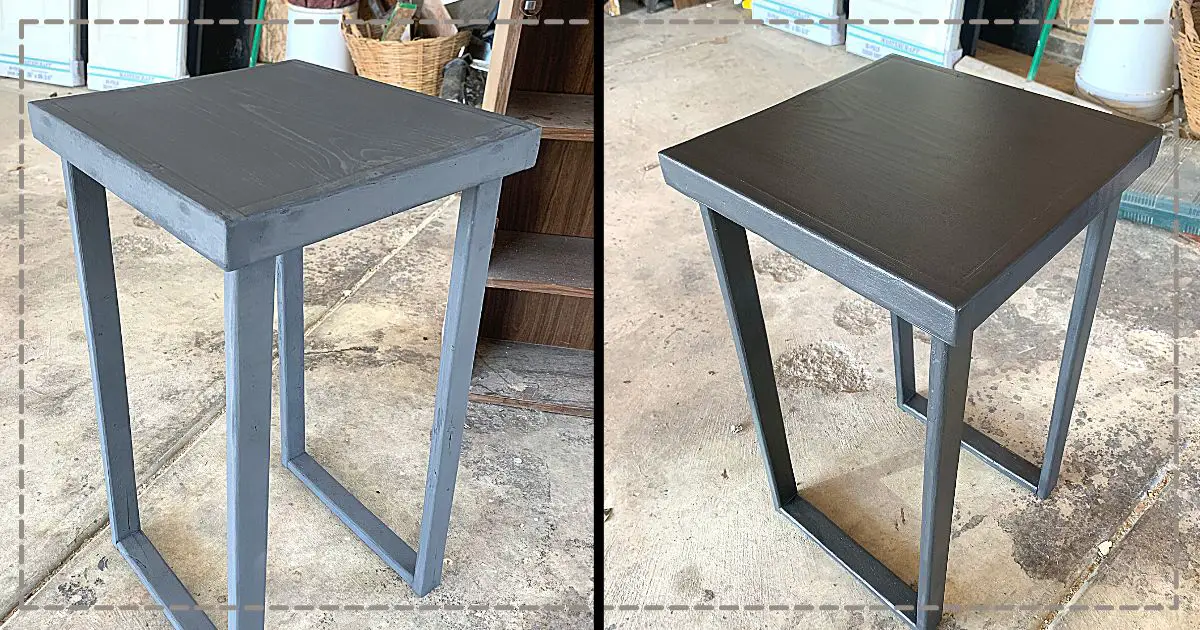*My posts may contain affiliate links, which means I may receive a small commission, at no cost to you, if you make a purchase through a link! Thank you for supporting my website!*
Last updated on February 28th, 2024 at 04:16 pm
Wondering how long you need to let paint dry before applying polyurethane? Well, look no further because I have your answer!
Most water-based paints dry within 1-2 hours while most oil-based paints dry within 2-4 hours. For best results, wait an hour after the paint feels dry to the touch before applying a topcoat.
Now that we’ve got the basics out of the way, let’s break into the details further so you can get the best finish on your painted project.
Let’s dive in!
Quick Navigation: Dry Times For Paint Before Applying Polyurethane
- When Can You Apply Polyurethane Over Paint?
- Dry Time Before Adding A Polyurethane Finish Over Water-Based Paint
- Dry Time Before Adding A Polyurethane Finish Over Oil-Based Paint
- Dry Time Before Adding A Polyurethane Finish Over Acrylic Paint
- Other FAQs About Paint & Polyurethane Dry Times
- Final Thoughts
When Can You Apply Polyurethane Over Paint?
Once the paint on the surface has cured, you can apply your polyurethane finish. This is the only factor you must consider carefully before applying polyurethane over a painted surface.
Most water-based paints such as chalk paints, milk paints, and latex paints take 1-2 hours to dry and cure.
Oil-based paints take a little longer to dry and cure. Most oil-based paints such as cabinet and furniture enamels take 2-4 hours to dry and cure.
Some specialty paints can take all the way up to 24 hours to dry (such as Beyond Paint). It’s best to read the manufacturer’s instructions for optimal cure times.
While the manufacturer’s instructions are helpful, other factors such as temperature or humidity could slow the process down.
To help avoid this potential problem, paint your project in a temperature-controlled room (such as your house or heated garage).
And leave the project in the unoccupied room while it dries so no dust particles are disturbed and land in the wet paint.
For best results, wait until the paint has thoroughly dried so as not to muddle or peel the layer of paint when the polyurethane is applied.

Popular Paint Brand Dry Times Before Applying Polyurethane
Here is a list of the most popular paint brands and how long you should let the paint dry before applying polyurethane.
(*NOTE: I’m assuming you are using water-based polyurethane over water-based paint and oil-based polyurethane over oil-based paint. If you are not, then you need to let the paint dry for a full 24 hours for water-based and a full 72 hours for oil-based.)
| Paint Brand | Dry Time Before Applying Polyurethane |
|---|---|
| Rustoleum Chalked Paint | 2 Hours |
| Rustoleum Milk Paint | 1 Hour |
| Country Chic Chalk Paint | 1 Hour |
| KILZ Tribute | 2 Hours |
| Beyond Paint | 24 Hours |
| Valspar Cabinet & Furniture Paint | 4 Hours |
| BEHR Premium Cabinet Door & Trim Enamel | 2 Hours |
| Magnolia Home By Joanna Gaines Cabinet & Furniture Paint Enamel | 2 Hours |
| Sherwin Williams ProClassic Waterborne Interior Acrylic Enamel | 1 Hour |
Dry Time Before Adding A Polyurethane Finish Over Water-Based Paint
Water-based paint is often the favorite paint to use for painting wood pieces, as it dries the quickest.
The average fast-drying water-based paint would be ready for a second coat or topcoat in only 2 hours.
Water-based paint does tend to show brushstrokes more than oil-based paint because of how fast it dries. However, it is much easier to work with and clean up after.
The bigger downfall is water-based paint is not usually as durable as oil-based paint for high-traffic furniture pieces.
Though, this can be easily avoided/fixed if you apply 3 coats of oil-based polyurethane overtop.
You just have to let the water-based paint dry for 24 hours before applying.

Dry Time Before Adding A Polyurethane Finish Over Oil-Based Paint
Oil-based paint takes twice as long as water-based paint to dry.
Most oil-based paints take closer to 2-4 hours to fully dry and are ready for a top coat.
However, this slower drying time helps the paint flatten and smooth out the majority of brushstrokes.
And since oil-based paint itself is a little more durable, adding 3 coats of polyurethane on top should give you the most success for the longevity of your painted project.
A good rule of thumb when applying polyurethane is to mix a little bit of your paint into it to help it blend in with the rest of the paint.
If you are using oil-based paint, then you can mix this into your oil-based polyurethane for a superior topcoat finish.
Don’t mix a water-based paint (such as chalk paint) with an oil-based polyurethane though. Instead, you can mix water-based paints with water-based polyurethanes (such as Polycrylic) to get the same effect.
Contrary to popular belief, that only pertains to mixing the wet liquids together. If you use water-based paint and let it dry fully, then you can use an oil-based polyurethane overtop.
To see more, check out my other article about oil-based polyurethane over water-based paint here.
Dry Time Before Adding A Polyurethane Finish Over Acrylic Paint
Acrylic paint is also water-based paint, so it typically dries fully within 1-2 hours as well.
Acrylic is not the best paint for furniture projects though because it takes several coats for full coverage and isn’t as durable as enamel (oil-based) paints.
Other FAQs About Paint & Polyurethane Dry Times
Here are some other frequently asked questions about applying polyurethane and paint dry times to help you get the best finish!
How Many Coats Of Polyurethane Is Recommended?
For both oil-based and water-based polyurethane, 3 coats are recommended. The first coat creates a rough texture on the painted surface, while the third coat creates a protected, smooth, and bright surface.
Why Should I Add A Polyurethane Finish Over A Painted Surface?
A polyurethane finish provides a smooth finish over a painted surface and protects the layer of paint from wear and tear. Polyurethane may also enhance the color of the paint by protecting the paint’s shine and color.

What Happens If I Don’t Wait Long Enough For Paint To Dry?
If the painted surface doesn’t dry well enough, the polyurethane finish could muddle or peel off layers of the paint, creating a rough finish. The surface will be more prone to wear and damage over time.
Final Thoughts On Paint & Polyurethane Dry Times
There you have it!
As long as you are painting and applying polyurethane in a temperature-controlled room, your painted projects should dry right on schedule and be ready for the next coat in 1-2 hours.
If you are ever unsure if your paint has dried fully, then give it another day before applying the topcoat to avoid ruining the paint job.
Catch you in my next post!


By Christine
Christine is a blogger and DIYer who tackles home renovation and decorating projects alongside her husband, Adam, for their personal residence and rental properties. Although she successfully tackles large renovation projects to avoid expensive contractor fees and bring her vision to life now, her path to success was not easy.
Go here to read her story, “From a Clueless First-Time Homebuyer To A Confident DIYer Creating Her Dream Home One Project At A Time“.
Popular Posts
DIY With Christine is a participant in the Amazon Services LLC Associates Program, an affiliate advertising program designed to provide a means for sites to earn advertising fees by advertising and linking to Amazon.com.






